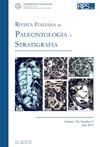LOWER TRIASSIC (INDUAN TO OLENEKIAN) CONODONTS, FORAMINIFERA AND BIVALVES FROM THE AL MAMALIH AREA, DEAD SEA, JORDAN: CONSTRAINTS ON THE P-T BOUNDARY
IF 1.6
3区 地球科学
Q2 GEOLOGY
引用次数: 11
Abstract
Upper Permian to Lower Triassic successions exposed in the Al Mamalih area, east of the Dead Sea, Jordan record the transition between the alluvial Umm Irna Formation (Upper Permian) and the overlying shallow marine Ma’in Formation (Lower Triassic). The Permian-Triassic boundary is constrained either within a hiatus represented by a sequence boundary between these formations or within ca 15 m of shallow marine beds overlying the boundary. Above the sequence boundary reddened, shallow-marine beds (Himara Member) mark the initial Triassic (presumed early Induan) marine transgression (Himara Member). Absence of both body fossils and vertical infaunal burrows indicates low-diversity, ecosystems following the Permian-Triassic extinction event. A gradational upward increase in grey, green and yellow siltstones beds (Nimra Member), accompanied by a concomitant increase in bioturbation (surface traces and infaunal vertical burrows), bivalves and brachiopods, stromatolites, conchostracans and lingulids in the lower part of the Nimra Member indicates colonisation of the substrate under shallow marine conditions during the recovery phase. Shallow-water carbonates in the Nimra Member yielded an abundant, low diversity assemblage of conodonts (e.g. Hd. aequabilis and H. agordina) and a foraminifera assemblage (Postcladella gr. kalhori-Earlandia spp.-Ammodiscus jordanensis n. sp.) that are interpreted as euryhaline recovery taxa that characterise the the mid-late Induan. Abundant new material has allowed revision of the conodont apparatus and the foraminifera include a new species Ammodiscus jordanensis n. sp. of Induan age. The discovery of the bivalves Claraia bittneri (C. aurita group) and Eumorphotis multiformis is worthy to note. Upper Permian alluvial lithofacies (Jordan) pass basinwards, about 50 km to the northwest, to coeval shallow marine siliciclastic and carbonates in the Negev and Mediterranean coast of Israel.约旦死海al mamalih地区下三叠世(冬至奥连纪)牙形刺、有孔虫和双壳类:p-t边界的约束
约旦死海以东Al Mamalih地区暴露的上二叠统至下三叠统序列记录了冲积型Umm Irna组(上二叠统)与上覆浅海相Ma’in组(下三叠统)之间的过渡。二叠纪-三叠纪界线被限制在以这些地层之间的层序界线为代表的裂谷内,或者被限制在边界上约15米的浅海床内。层序边界上方泛红的浅海相层(喜马拉段)标志着三叠纪初期(推测为早印度洋)海侵(喜马拉段)。身体化石和垂直动物洞穴的缺失表明二叠纪-三叠纪灭绝事件后的生态系统多样性低。灰色、绿色和黄色粉砂岩层(尼姆拉段)的逐步上升,伴随着尼姆拉段下部生物扰动(表面痕迹和水生垂直洞穴)、双壳类和手足类、叠层石、贝壳类和lingulids的增加,表明在恢复阶段,浅海条件下的基质被定殖。尼姆拉段的浅水碳酸盐岩产生了丰富的、低多样性的牙形刺组合(如Hd。aequabilis和H. agordina)和一个有孔虫组合(Postcladella gr. kalhori-Earlandia spp.-Ammodiscus jordanensis n. sp.)被解释为具有Induan中晚期特征的泛盐恢复分类群。大量的新资料使得牙形刺器官得到了修正,有孔虫类包括一新种——印尼时代的菊芋(Ammodiscus jordanensis)。双壳类Claraia bitneri (C. aurita组)和多形真形双壳类的发现值得注意。上二叠纪冲积岩相(约旦)向西北方向约50公里,穿过盆地,进入以色列内盖夫和地中海沿岸的同时期浅海硅酸和碳酸盐岩。
本文章由计算机程序翻译,如有差异,请以英文原文为准。
求助全文
约1分钟内获得全文
求助全文
来源期刊
CiteScore
3.60
自引率
4.30%
发文量
28
审稿时长
>12 weeks
期刊介绍:
The Rivista Italiana di Paleontologia e Stratigrafia was founded in 1895. It publishes original papers dealing with all fields of paleontology and of stratigraphy, from Italy and the Mediterranean to the Tethys, as well across the globe from China to North America.

 求助内容:
求助内容: 应助结果提醒方式:
应助结果提醒方式:


